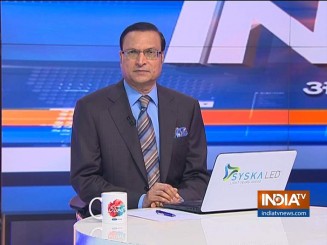 The total number of COVID-19 cases in India crossed 82,000 on Thursday with 3,995 fresh cases and 99 deaths reported during the last 24 hours, taking the death toll to 2,646. Nearly 27,686 patients have recovered. It was the fifth consecutive day of the graph rising at the rate of more than 3,500 a day.
The total number of COVID-19 cases in India crossed 82,000 on Thursday with 3,995 fresh cases and 99 deaths reported during the last 24 hours, taking the death toll to 2,646. Nearly 27,686 patients have recovered. It was the fifth consecutive day of the graph rising at the rate of more than 3,500 a day.
One picture is now clear: nearly 60 per cent of COVID-19 cases are confined to our big cities like Mumbai, Delhi, Chennai, Ahmedabad and Indore. It is now certain that the pandemic will continue for the next several months. With Lockdown 3.0 ending in the next two days, offices and factories will reopen, bus, rail and air services will resume, but the sword of Coronavirus will continue to hang over our heads.
Another point that is clear now is that with the massive migration of lakhs of workers by trains, buses and other means, the pandemic is spreading to far off towns and villages in the hinterland.
I spoke to senior doctors and scientists and they agreed that the pandemic is mostly limited to five states, where the situation is critical. On top of the list is Maharashtra. One out of every three COVID-19 cases in India is in Maharashtra, roughly 33 per cent. If you add Gujarat, Tamil Nadu, Delhi and Rajasthan to this, you have 73 percent COVID-19 patients in these five states, roughly three-fourth.
With nearly 60 per cent of cases presently confined to five cities, Mumbai, Delhi, Chennai, Ahmedabad and Indore, we can control the pandemic if the situation is tackled on a war footing in these five cities.
A total of 998 fresh cases were reported in a single day on Thursday from Mumbai. There are 17,377 COVID-19 patients presently in Mumbai hospitals. 4,234 patients have been discharged and the city’s death toll is at 621.
Our Mumbai reporter Rajiv Singh went to city hospitals. He reported that there are three major hotspots from where large number of cases has been reported: Dharavi, Kurla and Govandi. The patients are being treated in KEM, Sion, JJ, Cooper and Nair hospitals, all COVID-19 dedicated.
The dean of KEM Hospital, Dr Hemant Deshmukh said, there is no shortage of ventilators, oxygen or beds, but the major problem is that patients are coming only when their health turns critical and they start having severe breathing trouble.
More than 1,000 cases have been detected from Dharavi alone, and so far there have been 40 deaths in that locality. Our reporter visited the 90-feet road from Dharavi up to Matunga, and found almost all non-essential shops open, people freely walking around in crowds and even elderly people out on the road. This is a sure recipe to disaster.
The state government is now deploying 22 SRP and three RAF units in these localities to ensure lockdown and social distancing norms. In Matunga labour camp, our reporter noticed all shops and markets open with crowds walking around.
The same is the scene, more or less, in Ahmedabad. In the city alone, there are more than 6,500 out of total 9,000 cases in Gujarat. Most of the cases are confined to congested localities near the river Sabarmati in the old city. Till now, 446 have died in Ahmedabad, out of 566 deaths in Gujarat.
There is a bigger challenge awaiting. Lakhs of migrant labourers who have returned to their home states have become carriers of the deadly virus. Fresh cases are being reported from far off towns and villages.
In my prime time show ‘Aaj Ki Baat’, we showed how a 50-year-old migrant labourer Anirudh came out of a special train carrying 1100 labourers from Chandigarh at Bhagalpur station in Bihar, and fell unconscious. He was taken in an ambulance, but he died on the way. Authorities are carrying out tests of all the workers who travelled with him inside the train coach.
In Bihar, the total number of COVID-19 cases has shot up to 970, out of whom 352 are migrant workers who have returned home in the last ten days. Most of these have returned from Delhi, Haryana, Gujarat and Maharashtra. So far, more than two lakh workers have returned to Bihar, out of whom only 7,500 have been tested.
In Uttar Pradesh, 52 migrant workers have been tested positive in ten districts. Thousands of migrants have sneaked their way back to their villages and have evaded tests. Most of them could become a cause for worry in the coming weeks.
In the last ten days, nearly 10 lakh migrant workers were transported to their home states in more than 800 trains. The Centre spent Rs 11,000 crore on providing food to nearly 8 crore migrants.
So, apart from the metro hot spots, let us prepare for a bigger danger awaiting us: the virus spread in rural areas. There are thousands who have walked back to their villages bypassing all checks and quarantine. People in each village and small towns must be wary about the spread of virus.
Now that big and medium industries are reopening with the stimulus package from the Centre, let us all hope most of these migrants will return to their work. The Finance Minister has announced two months free food ration for each migrant worker, houses at affordable rents, ‘one nation, one ration card’ scheme for all migrants, and loans for street vendors. With factories reopening, let us hope, reverse migration will take place and these workers will return to their work.
Click Here to Watch Full Video | Get connected on Twitter, Instagram & Facebook